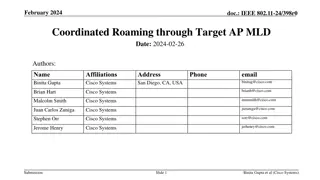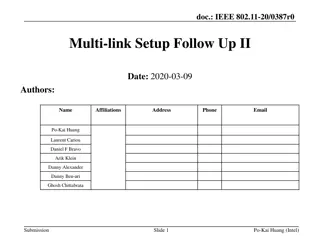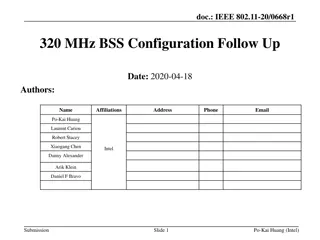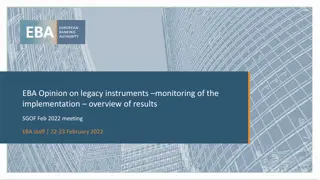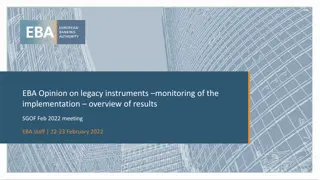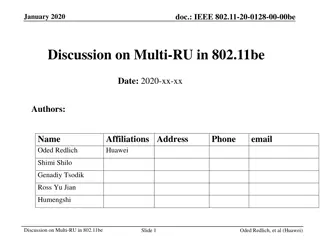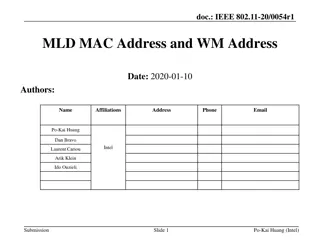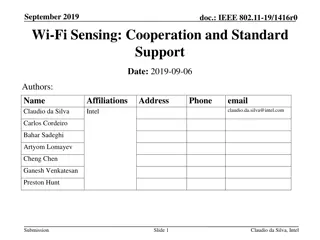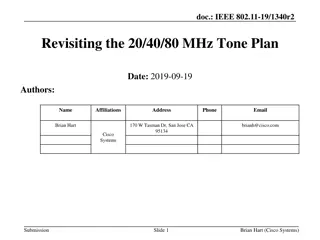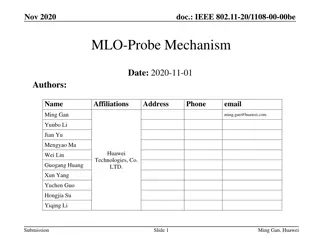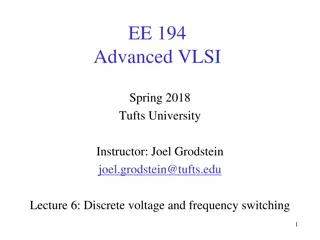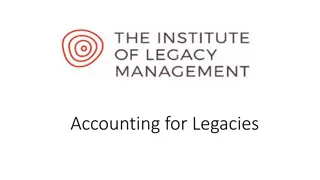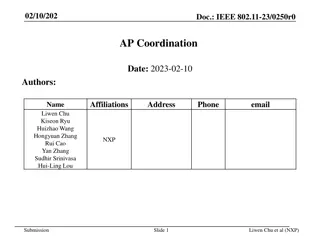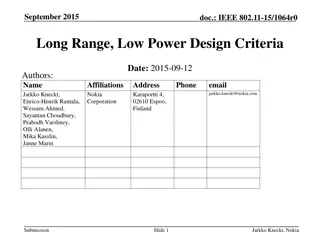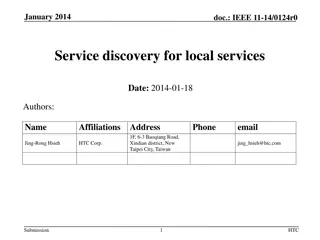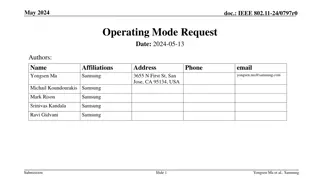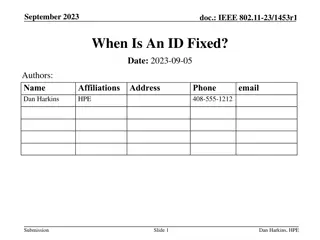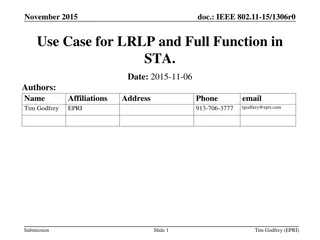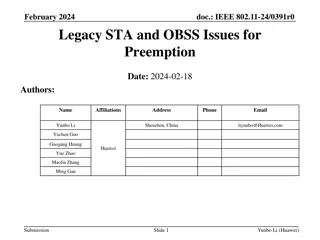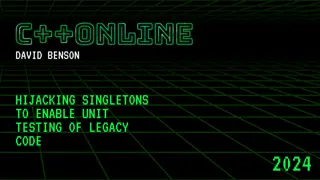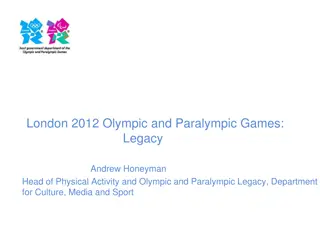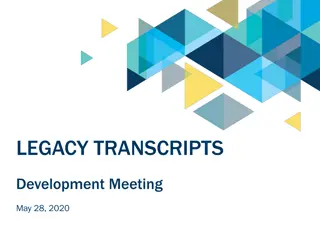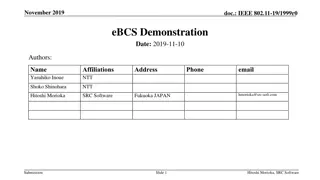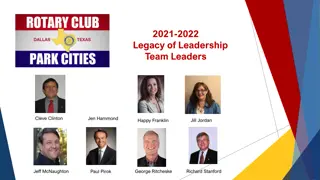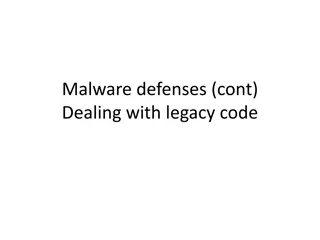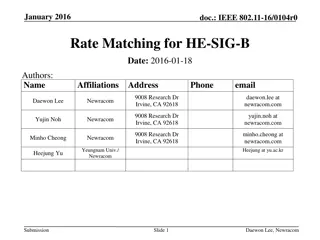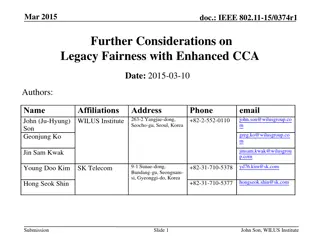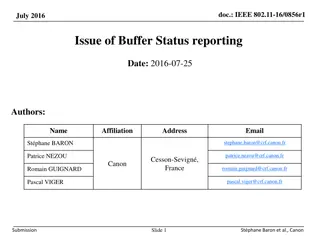Enhancing Low Latency Channel Access in Legacy IEEE 802.11 Networks
This document discusses the impact of introducing a Low Latency (LL) channel access mechanism in legacy IEEE 802.11 networks. It addresses the use of High Priority EDCA (HiP EDCA) mechanisms, proposing solutions for improving tail latency in both isolated BSS and multi-BSS scenarios. Additionally, i
2 views • 10 slides
Coordinated Roaming Proposal for IEEE 802.11 Networks
This document presents a proposal for coordinated roaming through target AP MLD in IEEE 802.11 networks to address connectivity disruptions due to sudden RSSI drops or STA transition scenarios. The solution aims to ensure data continuity, preserve context, and minimize data loss during roaming hando
0 views • 11 slides
Progress on IEEE 802.11 Multi-link Setup
Significant developments have been made in the multi-link setup within the IEEE 802.11 framework. The focus is on allowing only one STA in the MLD framework, differentiation with STA-level associations, and the rationale behind restricting to one STA. Proposals for defining multi-link devices and re
0 views • 12 slides
IEEE 802.11-20/0668r1: EHT BSS Configuration Proposal
The document discusses the configuration of a 320 MHz BSS in the context of 6 GHz regulations, focusing on EHT operation elements such as channel width indication, CCFS principles, and BSS advertisement settings. It proposes design principles for managing legacy and EHT STA operations, emphasizing s
0 views • 14 slides
EBA Opinion on Legacy Instruments Monitoring Implementation Overview - Feb 2022 Meeting
The European Banking Authority (EBA) provided an opinion on legacy instruments monitoring at their Feb 2022 meeting. The presentation covers the monitoring in 2021, surveys, letters to competent authorities, and the overview of monitoring results. It discusses calls for input on the implementation o
0 views • 20 slides
Overview of EBA Opinion on Legacy Instruments Monitoring Implementation Results Feb 2022
In February 2022, the European Banking Authority (EBA) conducted monitoring on legacy instruments implementation. The presentation covers surveys, input from competent authorities, and outcomes. Efforts to address infection risks posed by legacy instruments were highlighted, with actions taken by in
1 views • 20 slides
The Benefits of Investing in Custom Creative Banner Stands for Trade Shows
The crowd passes by the road every day and sees many advertisements. However, poor visibility due to texture and quality can negatively impact advertising standards and the brand image. I recommend using PosterGarden\u2019s custom Creative Banner Sta
1 views • 11 slides
Discussion on Multi-RU Allocation in IEEE 802.11be Standard
In January 2020, a discussion took place on the allocation of multiple Resource Units (RUs) to a single Station (STA) in the IEEE 802.11be standard. The proposal suggested categorizing RUs into small and large types, avoiding aggregation across multiple 20MHz channels. It emphasized assigning a sing
2 views • 29 slides
Understanding IEEE 802.11-22/2083r1 Wake-Up Radio (WUR) and MC-OOK Signals
The document explores the IEEE 802.11-22/2083r1 specifications regarding Wake-Up Radio (WUR) PHY, focusing on WUR PPDU reception requirements and the use of multicarrier on-off keying (MC-OOK) signals. It examines the ambiguity surrounding MC-OOK in WUR PPDU compositions, emphasizing the need for cl
0 views • 27 slides
IEEE 802.11-20/0054r1 MLD MAC Address and WM Address
In the document IEEE 802.11-20/0054r1, the focus is on Multi-Link Framework for MLD address identification and differentiation. It explains the usage of MLD MAC address and STA WM medium address in wireless setups. The document also addresses the need for identifying different MLDs using MAC address
0 views • 16 slides
Exploring Wi-Fi Sensing for Motion Detection and Beyond
The document discusses the utilization of Wi-Fi signals for sensing various features in a given environment, such as motion, presence, gesture, and more, without assuming the subject carries a Wi-Fi device. It covers applications, technical principles, and a three-phase algorithm for motion detectio
0 views • 24 slides
Revisiting the IEEE 802.11-19/1340r2 Tone Plan Optimization
Revisiting the tone plan optimization for IEEE 802.11-19/1340r2, addressing issues with RUs near band edges, accommodating various STA bandwidth capabilities, and the inefficiencies of non-SST 11ax STAs in different BSS scenarios. Proposals include adapting to unknown future 11ax features, minimizin
5 views • 12 slides
Considerations on 6 GHz Discovery for IEEE 802.11-18/1922r0
IEEE 802.11-18/1922r0 document discusses the background and regulatory context for supporting 6 GHz operation in 802.11ax networks. It focuses on optimizing the discovery process for 6 GHz channels to enhance STA and network KPIs. The typical scanning/discovery procedure for non-AP STAs is outlined,
2 views • 14 slides
Comparison of Trigger-based vs. Non-Trigger-based Sensing Measurement in IEEE 802.11
The document discusses the differences between Trigger-based (TB) and Non-Trigger-based (Non-TB) sensing measurement instances in IEEE 802.11 standards, focusing on who initiates the sensing measurement. TB sensing is initiated by the AP, while Non-TB sensing is initiated by a non-AP STA, enabling o
6 views • 13 slides
IEEE 802.11-20/1108-00-00be MLO Probe Mechanism in AP MLD
This document discusses the design and implementation of a mechanism for a non-AP STA to send a probe request frame to an AP within an AP MLD, allowing the STA to request a probe response containing information on all APs affiliated with the same MLD as the target AP. It proposes the use of new elem
1 views • 12 slides
Veterans Benefits Appeals and Legacy Appeals Process
Learn about the appeals process for denied VA benefits claims and the legacy appeals system for claims decided before February 19, 2019. Understand your rights to appeal decisions, examples of appealable decisions, actions that cannot be appealed, and the differences between Legacy Appeals and the A
3 views • 78 slides
Understanding Dynamic Voltage and Frequency Scaling in Advanced VLSI
Explore the concepts of Dynamic Voltage and Frequency Scaling (DVFS) in Advanced VLSI design. Learn about the impact on clocking, STA, and testing, as well as considerations for selecting the right voltage and frequency settings. Discover how controlling voltage affects power consumption and computa
0 views • 51 slides
IEEE 802.11-20/0644r0 NAV Setting in Multi-AP Operation
This document discusses the NAV setting in multi-AP operations within the IEEE 802.11-20 standard. It covers terminology, background information, and proposed solutions to address issues related to AP cooperation and UL AP coordination. The authors suggest adjustments to NAV rules and frame duration
0 views • 9 slides
Insights into Legacy Accounting and Submissions
The legacy market is expected to grow significantly, with legacies becoming a crucial income source for UK charities. The emphasis on standardizing accounting methods for legacies is highlighted, aiming to enhance efficiency, accuracy, and forecasting. Key submissions propose uniformity in legacy ac
0 views • 22 slides
Enhanced AP Coordination in IEEE 802.11 Networks
The document discusses the implementation of Restricted Transmit Wait Time (R-TWT) scheduling in IEEE 802.11 networks. It covers topics such as AP coordination, announcement of R-TWT schedules by APs, usage of 1-hop and 2-hop neighbor information for scheduling, and STA's notification of neighbor AP
0 views • 7 slides
IEEE 802.11-15/1064r0 Long Range, Low Power Design Criteria Study
Submission on design criteria for Long Range, Low Power (LRLP) in WLAN systems aiming to enhance transmission reliability and range while ensuring compatibility with existing WLAN networks. The key technical components include ultra-low power consumption, communication range extension, and coexisten
0 views • 8 slides
Service Discovery for Local Services in IEEE 11-14/0124r0 Document
Elaboration on non-tethering Soft AP and possible service network scenarios in the January 2014 IEEE document. It discusses the concept of non-tethering Soft APs, their operation in the vicinity, and the categories of use scenarios related to Internet access and service discovery. The document cover
0 views • 9 slides
Virtual Carrier Sense in Multi-Link Networks
This document discusses the implementation and advantages of virtual carrier sense in multi-link networks under the IEEE 802.11 standard. It explores the operation of multi-link setups, asynchronous communication benefits, and the necessity of multiple contention channels. The concept of NAV (Networ
2 views • 11 slides
Enhancing Support for Wider Bandwidth OFDMA in IEEE 802.11 Networks
The document discusses the implementation of Selective Spatial Transmission (SST) and Dynamic Subband Operation (DSO) to enable wider bandwidth OFDMA in IEEE 802.11be and 802.11bn standards. It covers enhancements for 80MHz, 160MHz, and 320MHz EHT DL and UL OFDMA transmissions, emphasizing the benef
0 views • 18 slides
AMP Link Access Modes in IEEE 802.11-24 Presentation
Presented in the March 2024 document IEEE 802.11-24/0421r0, Solomon Trainin from Wiliot discusses three modes of AMP link access, including random access of multiple AMP STAs, access of a single AMP STA, and exemplary frame exchanges for each mode.
0 views • 10 slides
Legacy Giving Made Easy for Your Parish
Legacy giving is a crucial way to support nonprofits and churches through planned giving techniques, ensuring their sustainability for the future. Learn about the importance of legacy gifts and how they can shape the long-term success and impact of organizations. Discover why legacy giving is vital
0 views • 14 slides
IEEE 802.11-24/0797r0 Operating Mode Request
This document proposes an Operating Mode Request mechanism for STAs within the IEEE 802.11 standard. It allows a STA to request another STA to change its operating mode, such as bandwidth and number of spatial streams. The proposal outlines the reasons for making such requests and the acceptance/den
0 views • 10 slides
Implications of IEEE 802.11 State Machine and MAC Randomization
The document discusses the state machine transitions in IEEE 802.11, focusing on MAC address handling and implications for STA connectivity within an ESS. It explains the scenarios where a STA can use different MAC addresses, emphasizing the binding of state to specific address configurations and th
0 views • 11 slides
IEEE 802.11-15/1306r0 Use Cases for LRLP and Full Function in STA
The documents related to IEEE 802.11-15/1306r0 explore various use cases for LRLP (Low-Rate Longevity-Performance) and full functional capabilities in Single Terminal Architecture (STA). Tim Godfrey from EPRI presents scenarios where AP/STA pairings with 802.11ax and LRLP are approved and deployed,
0 views • 7 slides
Legacy STA and OBSS Preemption Considerations in IEEE 802.11-24
Discussions in IEEE 802.11-24 address preemption issues related to UHR STAs within a single BSS, focusing on legacy STA impact and OBSS considerations. Proposed solutions aim to balance efficiency and latency by adjusting TXOP limits for different STA types.
0 views • 7 slides
Unit Testing Legacy Code: Hijacking Singletons for Testing
Enabling unit testing of legacy code requires making changes without altering existing calling code. Singleton pattern poses challenges for testing, but strategies such as hijacking can be employed for effective unit testing. David Benson shares insights on legacy code attributes and unit testing ap
0 views • 39 slides
London 2012 Olympic Legacy Achievements
The legacy of the London 2012 Olympic and Paralympic Games has been remarkable, with significant achievements in sport participation, economic benefits, venue retention, and community engagement. Key highlights include a notable increase in people playing sports, substantial investments in grassroot
0 views • 20 slides
Legacy Transcripts Development Meeting Summary
Legacy Transcripts project aims to show progress in developing a web-based application to pull data from legacy systems into a single database for colleges transitioning to ctcLink. The iterative development process involves reviewing, testing, and deploying the application in smaller cycles until i
0 views • 10 slides
Implementation and Demonstration of eBCS Concept in IEEE 802.11-19/1999r0
This presentation showcases the implementation and demonstration of the eBCS concept, including the system architecture, utilization of eBCS AP and STA, web server functionality, and data transmission processes. It covers the use of LDPC-Staircase/Triangle for packet transmission, IP multicast for d
0 views • 9 slides
Legacy of Leadership: Team Leaders and Cohorts 2018-2022
Explore the legacy of leadership through the team leaders and cohorts from 2018 to 2022. Witness the growth and impact of individuals like Cleve Clinton, Jill Jordan, Happy Franklin, and more as they lead and contribute to the legacy of leadership. Each cohort brings a unique blend of talent and exp
0 views • 4 slides
Faith and Legacy - A Journey of Conviction and Hope
The journey of faith and legacy intertwines with past roots and future confidence, revealing the righteousness of God through acts of faith. A young girl's emotional reaction to a touching scene, coupled with powerful messages of assurance and creation, highlight the significance of living by faith
0 views • 9 slides
Modern Strategies for Legacy Code Security
Explore advanced defenses against malware in legacy code, including techniques like NX bit implementation, randomizing layouts, and canaries. Learn about tools like Libsafe for dynamically intercepting risky function calls and enhancing security. Discover the effectiveness of methods like StackShiel
0 views • 25 slides
January 2016 IEEE 802.11-16/0104r0: Rate Matching for HE-SIG-B
The document from January 2016 focuses on rate matching for HE-SIG-B in IEEE 802.11-16/0104r0 standard. It delves into the encoding/decoding structure, example of SIG-B with code-rate, MCS table, proposed encoding method for HE-SIG-B, and the structure of HE-SIG-B per-STA information field. The cont
0 views • 10 slides
Legacy Fairness Enhancement in IEEE 802.11 Networks: Further Considerations
Investigating legacy fairness issues in IEEE 802.11 networks, this document explores methods to address throughput starvation of legacy stations due to enhanced Channel Clear Assessment (CCA) in High Efficiency (HE) stations. Two fairness methods, Legacy Frame Protection and PPDU Size Reduction, are
0 views • 9 slides
Efficient UL Buffer Status Reporting in IEEE 802.11 Networks
IEEE 802.11-16/0856r1 discusses the importance of UL buffer status reporting in 11ax for efficient resource allocation. The document addresses managing unmanaged P2P flows to enhance buffer status reporting accuracy. It proposes solutions to prevent misallocation of resources due to large data amoun
0 views • 11 slides

